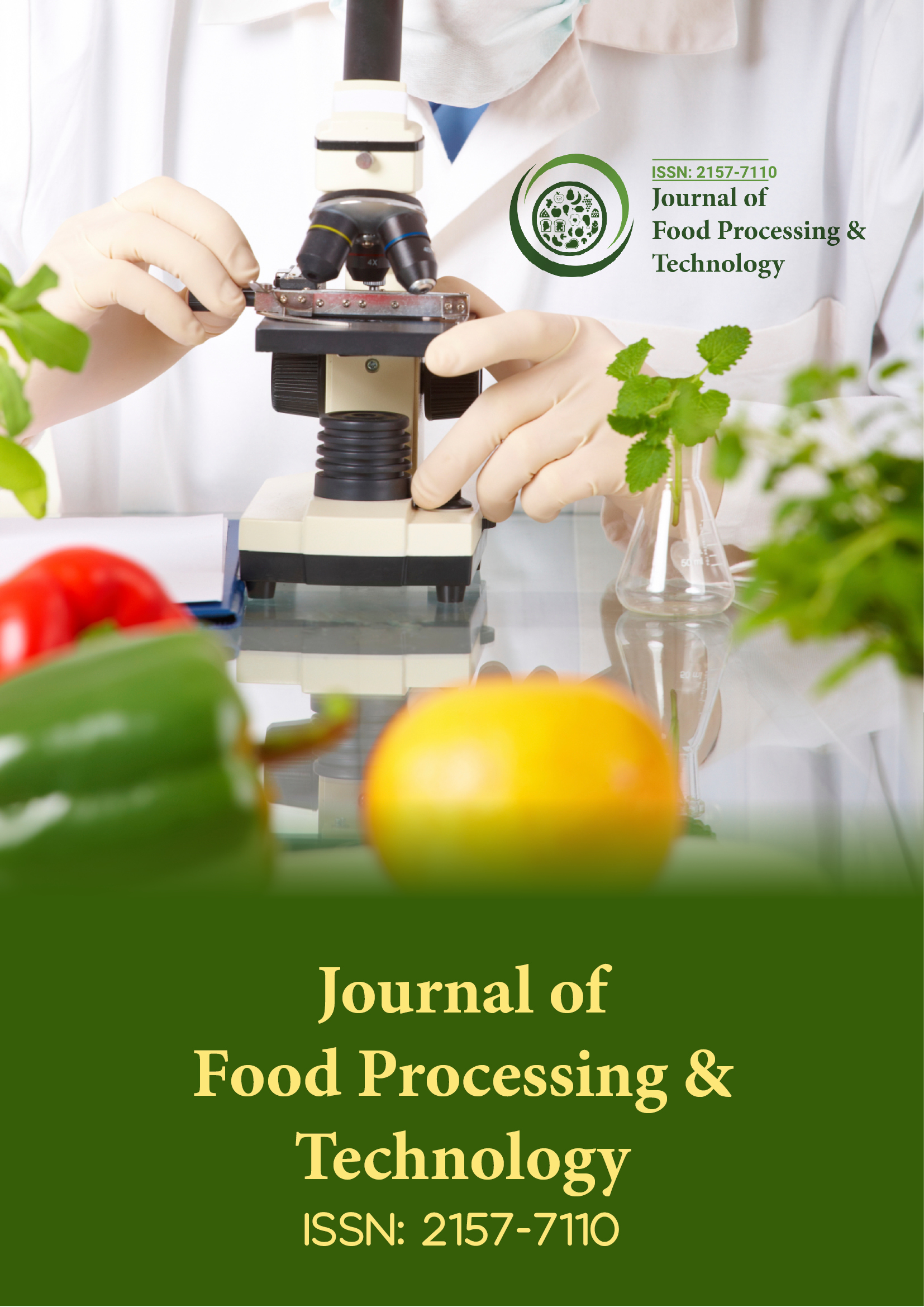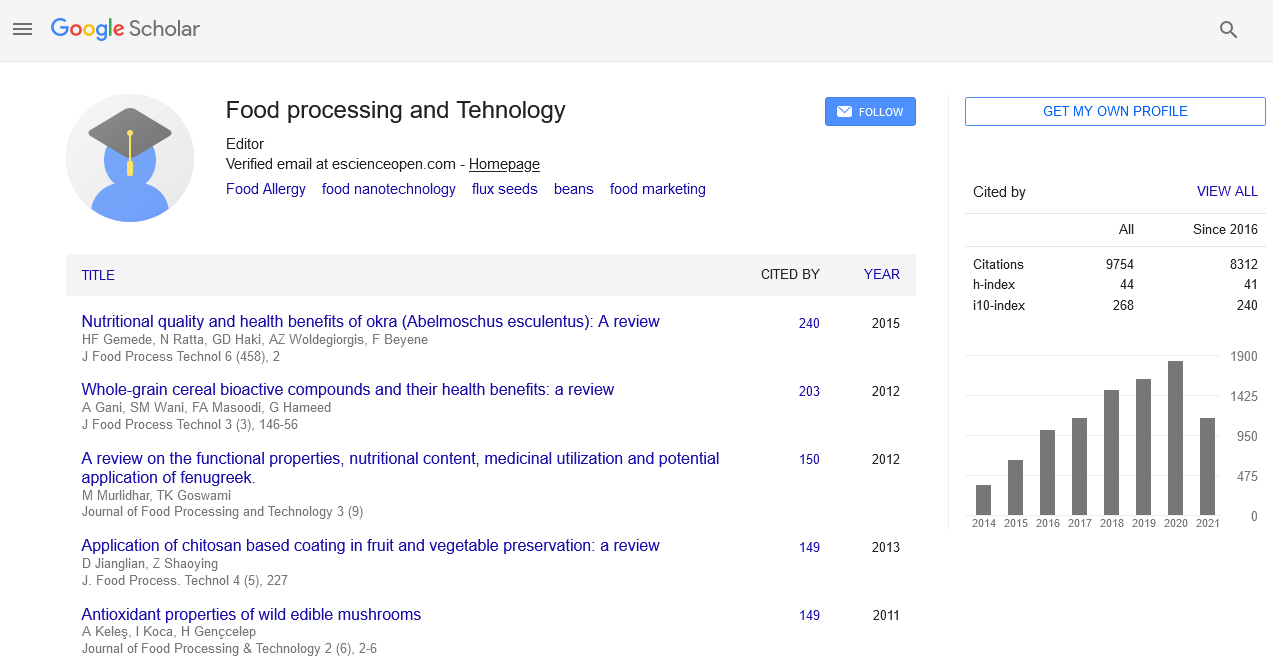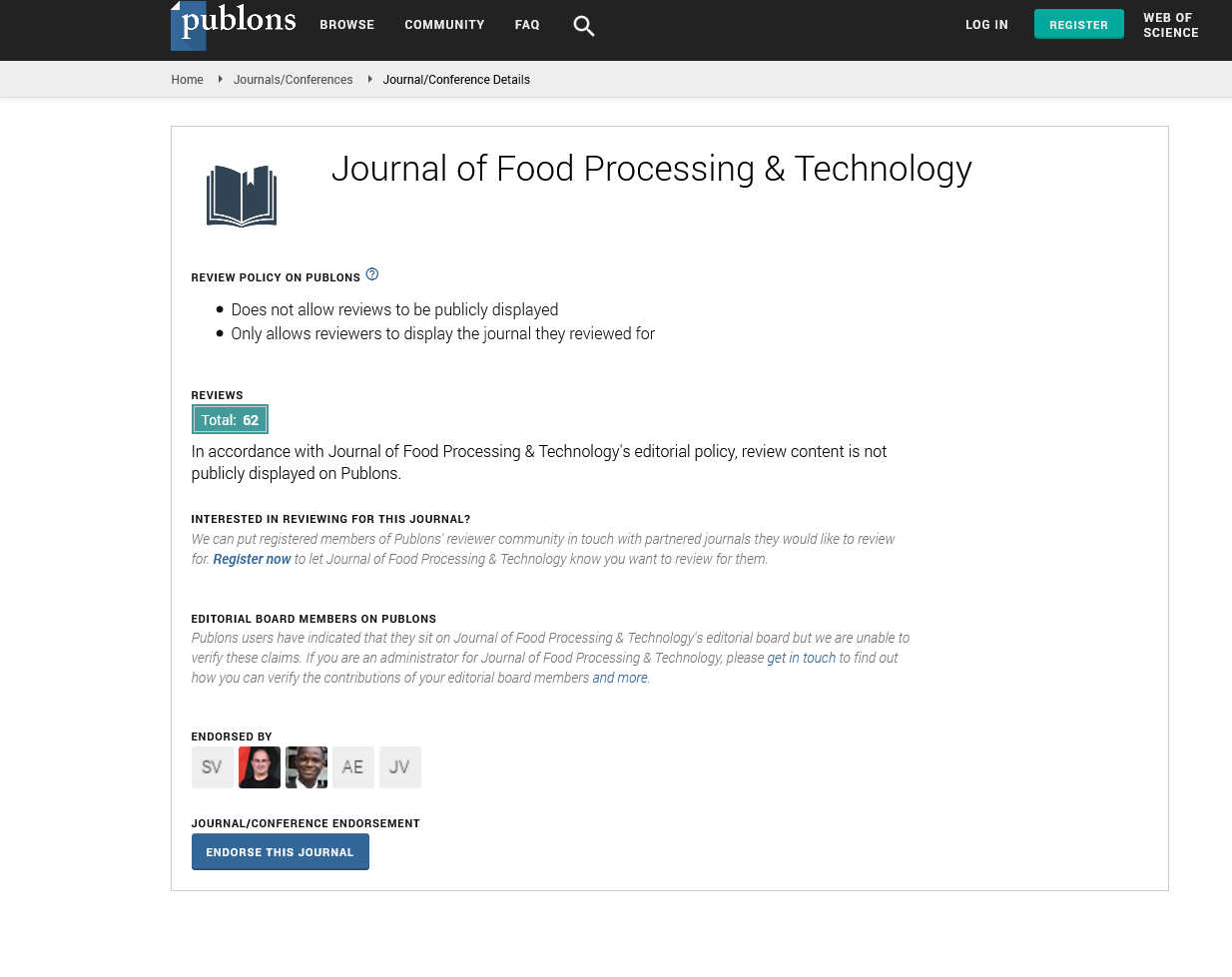Indexed In
- Genamics JournalSeek
- Academic Keys
- JournalTOCs
- China National Knowledge Infrastructure (CNKI)
- Access to Global Online Research in Agriculture (AGORA)
- Centre for Agriculture and Biosciences International (CABI)
- RefSeek
- Directory of Research Journal Indexing (DRJI)
- Hamdard University
- EBSCO A-Z
- OCLC- WorldCat
- Scholarsteer
- SWB online catalog
- Publons
- Euro Pub
- Google Scholar
Useful Links
Share This Page
Journal Flyer

Open Access Journals
- Agri and Aquaculture
- Biochemistry
- Bioinformatics & Systems Biology
- Business & Management
- Chemistry
- Clinical Sciences
- Engineering
- Food & Nutrition
- General Science
- Genetics & Molecular Biology
- Immunology & Microbiology
- Medical Sciences
- Neuroscience & Psychology
- Nursing & Health Care
- Pharmaceutical Sciences
Opinion Article - (2025) Volume 16, Issue 2
Food Safety Challenges and Solutions in Global Supply Chains
Michael Thompson*Received: 28-Mar-2025, Manuscript No. JFPT-25-29638; Editor assigned: 31-Mar-2025, Pre QC No. JFPT-25-29638; Reviewed: 14-Apr-2025, QC No. JFPT-25-29638; Revised: 22-Apr-2025, Manuscript No. JFPT-25-29638; Published: 28-Apr-2025, DOI: 10.35248/2157-7110.25.16.1153
Description
The expansion of global food trade has transformed how people eat, shop and experience food. Consumers today can enjoy fruits, vegetables, seafood and processed products from almost any part of the world regardless of season. This interconnected system has increased convenience and variety but also created complex challenges in ensuring that food remains safe from production to consumption. As supply chains stretch across continents, even a single lapse in safety standards can have far-reaching consequences for public health and economic stability. Maintaining safety within these systems requires collective responsibility among farmers, manufacturers, distributors, regulators and consumers. Microbial contamination continues to be one of the most significant threats in international food trade. Pathogens such as Salmonella, Listeria monocytogenes and Escherichia coli can easily travel across borders through contaminated raw materials or improperly handled products. These microorganisms can cause widespread foodborne illnesses, which not only endanger consumers but also lead to costly product recalls and damage to brand reputation. Preventing such contamination begins with good agricultural and manufacturing practices, including sanitation, water quality control and employee hygiene. Regular microbial testing at different points of production and distribution is essential to identify potential hazards early. The implementation of Hazard Analysis and Critical Control Point (HACCP) systems has become a standard approach to manage risks systematically in many food industries worldwide.
Alongside biological hazards, chemical contamination poses another major concern. Pesticide residues, heavy metals and veterinary drug remnants can enter the food chain if regulatory standards are not properly enforced. Industrial pollutants and unintentional chemical migration from packaging materials can further complicate safety assurance. International organizations, particularly the Codex Alimentarius Commission, have established global guidelines to harmonize food safety standards. This harmonization allows smoother trade between nations and ensures that food products meet acceptable limits for contaminants regardless of their origin. However, differences in enforcement and testing capacity among countries can still create vulnerabilities. Strengthening regulatory systems and promoting transparency between trading partners remain critical to maintaining consumer protection. Traceability has emerged as an essential aspect of modern food safety systems. With products moving through multiple intermediaries, the ability to track their origin and journey is vital for quick response when contamination is detected. Advanced traceability methods such as barcoding, Radio-Frequency Identification (RFID) and blockchain technology are increasingly being used to record and verify every stage of the supply chain. Blockchain, in particular, provides a tamper-resistant digital ledger that allows participants to view verified data in real time. This transparency helps identify the source of contamination faster and enables efficient recall of affected products, minimizing health risks and financial loss.
Food fraud adds another layer of complexity. Mislabeling, dilution and substitution of ingredients whether intentional or accidental can compromise both safety and authenticity. Fraudulent activities not only deceive consumers but can also introduce untested or harmful substances into food. To combat this, analytical tools such as DNA barcoding, isotope ratio analysis and spectroscopic fingerprinting are increasingly being applied to verify ingredient authenticity and detect adulteration. These technologies give regulators and industries stronger tools to ensure integrity within global food markets. Temperature control throughout the supply chain is equally important, particularly for perishable products like dairy, seafood and meat. The cold chain the network that maintains proper refrigeration from farm to consumer prevents microbial growth and spoilage. Any break in this chain can rapidly lead to unsafe products reaching consumers. Smart sensors and Internet of Things (IoT) devices are now being used to continuously monitor temperature and humidity conditions during transport and storage. These technologies send real-time alerts when deviations occur, allowing immediate corrective action and reducing waste. Cooperation among regulatory agencies plays a central role in global food safety management. Since food trade crosses multiple borders, consistent enforcement and informationsharing among national authorities help detect risks early. Joint inspections, shared databases and regional training programs have strengthened collaboration between countries. Such collective efforts make it possible to track emerging pathogens, prevent illegal trade of unsafe goods and build confidence in international food exchanges. Consumer education is another important factor in the overall system. Even the most advanced technologies cannot guarantee safety if food is mishandled at home. Awareness programs focusing on safe storage, cooking temperatures and hygiene can significantly reduce preventable foodborne illnesses. Governments, schools and public health organizations regularly issue guidelines to help individuals make informed decisions about the foods they buy and prepare.
Looking ahead, digital transformation continues to influence how food safety is managed. Artificial intelligence, big data analytics and predictive modeling are being integrated into risk management systems. By analyzing large datasets from sensors, inspection reports and supply chain records, these tools can predict potential hazards before they lead to outbreaks. Early warning systems built on predictive analytics can assist authorities and companies in preventing contamination events rather than simply responding to them. The safety of food in an interconnected global system depends on a combination of technological innovation, effective regulation and shared responsibility. As supply chains become more extensive and consumer expectations continue to evolve, continuous adaptation will be necessary. Ensuring safe, high-quality food for a growing global population will rely on collaboration among producers, scientists and policymakers, supported by informed and cautious consumers. Food safety is not merely a technical requirement it is a foundation of public trust and a critical factor in sustaining the benefits of global food trade.
Citation: Thompson M (2025). Food Safety Challenges and Solutions in Global Supply Chains. J Food Process Technol.16: 1153.
Copyright: © 2025 Thompson M. This is an open access article distributed under the terms of the Creative Commons Attribution License, which permits unrestricted use, distribution and reproduction in any medium, provided the original author and source are credited.


